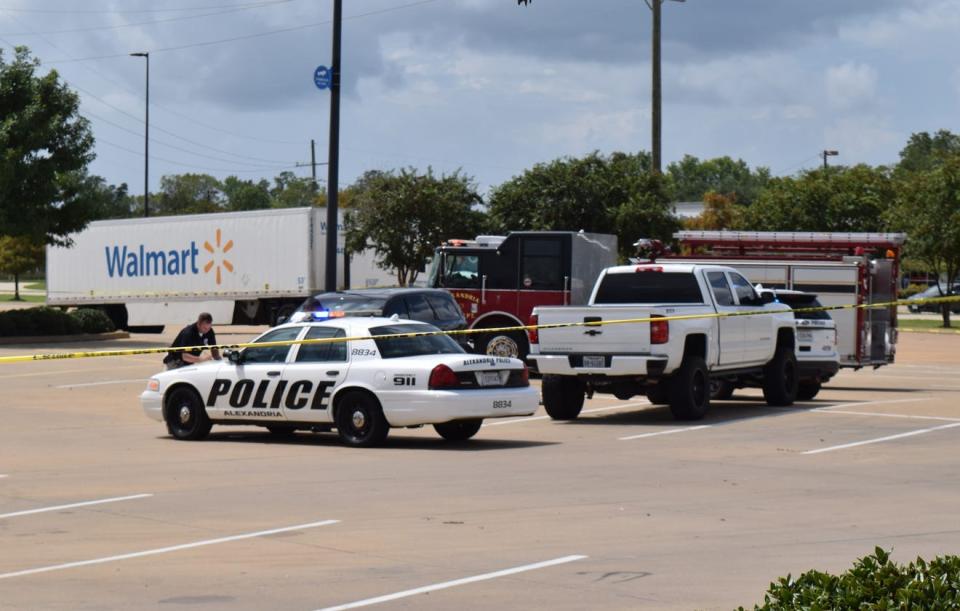Kayla Giles' 2nd-degree murder trial continues with crime scene testimony
An Alexandria Police Department crime scene investigator spend most of Tuesday morning on the stand on the second day of the Kayla Giles second-degree murder trial.
Giles faces the homicide count and a charge of obstruction of justice in the Sept. 8, 2018, shooting of her estranged husband, 30-year-old Thomas Coutee Jr.
Sgt. Chris Fonville was the first witness called by Louisiana Assistant Attorney General Joseph LeBeau, who asked him to describe the scene when he arrived.

Coutee already was dead, said Fonville, and the gun used to shoot him had been removed from the Dodge Durango driven by Giles. LeBeau asked if that was procedure, but Fonville answered that will sometimes happen if safety is an issue or the scene is chaotic.
LeBeau guided Fonville through describing photos he took at the scene in the Walmart parking lot on Coliseum Boulevard. One of the photos was of a cartridge casing from the Ruger LCP .380 pistol that had been in Giles' vehicle, he said.
The Ruger had been placed in a patrol unit. When Fonville collected it, he found one hollow-point bullet in the chamber and three more in the magazine, he testified.
Initial coverage: Wife served court order before deadly Louisiana Walmart shooting
Trial day 1 coverage: State says Kayla Giles is 'cold, calculating,' but defense says she was protecting herself
Coutee's mother sobbed quietly as photos of Coutee and the surrounding scene were displayed for jurors.
LeBeau asked how a hollow-point bullet differed from a normal bullet, and Fonville said a regular bullet will hold its shape when fired. A hollow-point bullet will mushroom upon impact to "cause as much damage as possible," he said.
LeBeau asked Fonville if he was asked to do anything with the gun. He said the lead detective asked him to run its serial number through a federal government tracing program, which showed that Giles had bought the gun 12 days prior at a Dallas store.
Fonville said he also collected surveillance video from the nearby Sonic restaurant, watching it and directing a manager what to put on a thumb drive he supplied. Surveillance video from Walmart was collected by another detective, who gave it to Fonville, he testified.
Two days after the shooting, Fonville testified that he went to Giles' home after a search warrant had been obtained. The open box for the Ruger was found in the kitchen, he said.
Giles' attorney, George Higgins III, questioned Fonville on whether he was aware that Coutee had been rolled over and he knew if the cartridge case had been moved by those trying to save him. He said it was possible that the cartridge case had been moved.
Higgins asked Fonville if he knew Coutee before his death and whether he'd attended any of his mixed martial arts fights. Fonville replied he didn't know Coutee and didn't believe he had attended any of his fights.
The defense attorney grilled Fonville when he said he didn't have the name of the Sonic manager who gave him the video and about the length of the video. He asked Fonville if he knew how many people had a key to Giles' home.
When Fonville replied that he didn't know, Higgins asked him if he only took direction from others in investigations, that he didn't undertake his own investigations. Fonville said he did not
Fonville told Higgins he did not find any fingerprints on the Ruger box, which Higgins pounced on.
"Just because you touch something doesn't mean you leave fingerprints," said Fonville.
Or, Higgins replied, somebody, didn't want to leave fingerprints behind. He asked Fonville if Coutee's home was searched and whether there were photos of the glovebox in his vehicle.
He also grilled Fonville on whether ballistics or trajectory testing was done in the case. Fonville said no ballistics testing was done and that trajectory testing wouldn't have accomplished much since the bullet hit only Coutee.
When LeBeau got to ask Fonville questions again, he asked if Coutee was under investigation. Fonville said no.
He asked if Coutee's truck was searched. Fonville said, other than a cellphone, no gun or anything else was found.
"Was there any question who fired that gun?" LeBeau asked.
Fonville said no, then said Giles had admitted to being the shooter while at the scene.
Testimony will continue on Tuesday afternoon.
This article originally appeared on Alexandria Town Talk: Kayla Giles trial: Crime scene photos, evidence focus of testimony

